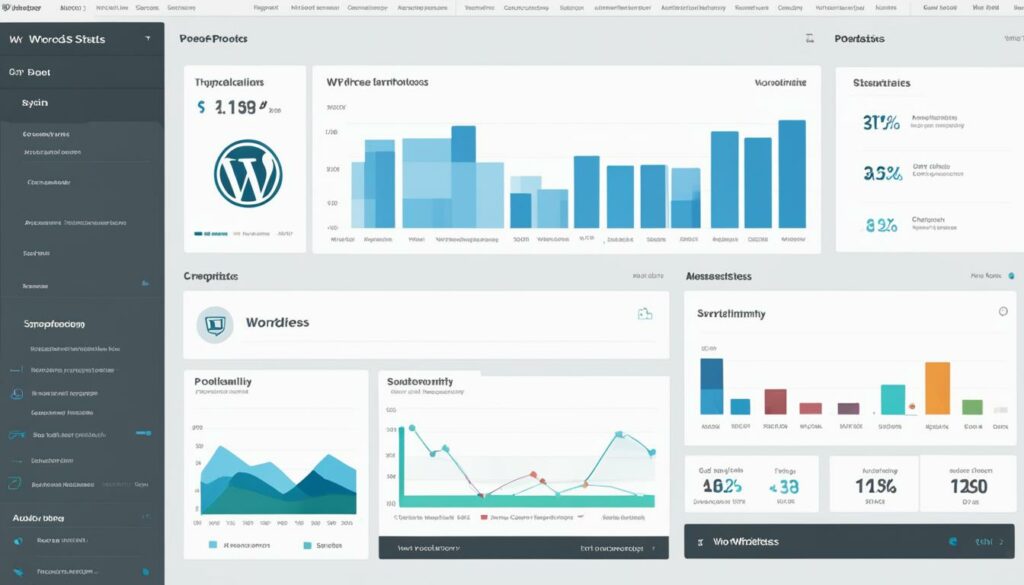Welcome to the world of conversion rate optimization (CRO), where maximizing your website’s potential to generate leads and increase sales is the name of the game. In this fast-paced digital landscape, having a high conversion rate is crucial for the success of your e-commerce business. So, how can you optimize your website to ensure that visitors not only stick around but also complete the desired actions that lead to conversions? Let’s delve into some tried and tested CRO tips that can take your online sales to the next level.
Key Takeaways:
- Conversion rate optimization (CRO) focuses on increasing the percentage of website visitors who complete desired actions.
- CRO involves strategies such as content enhancements, A/B testing, and workflow improvements to improve user experience and drive conversions.
- A good conversion rate depends on various factors, including industry, niche, goals, and audience demographics.
- CRO and SEO work hand in hand to maximize the potential of your online presence and drive sales.
- Implementing a CRO strategy in key areas of your website, such as the homepage, pricing page, blog, and landing pages, can greatly impact your conversion rates.
What is Conversion Rate Optimization?
Conversion rate optimization (CRO) is a crucial process for improving the percentage of conversions on your website or mobile app. By identifying and implementing strategies to improve user experience and optimize conversion rates, you can maximize the value of your existing visitors and users. CRO involves generating ideas for enhancing various elements of your site or app and then validating those ideas through A/B testing and multivariate testing.
Improving your conversion rate through CRO has several benefits. First, it allows you to lower customer acquisition costs by getting more value from your existing audience. Secondly, optimizing your conversion rate can increase the revenue generated from each visitor, leading to overall revenue growth. Lastly, by acquiring more customers through increased conversion rates, you can drive the expansion of your business.
The goal of CRO is to understand how users interact with your site or app, what actions they take, and what might be preventing them from completing their goals. By making improvements targeted at enhancing the user experience and addressing any barriers to conversion, you can increase the likelihood of visitors taking the desired actions.
A/B testing and multivariate testing are crucial tools for the CRO process. These testing methods allow you to test multiple variations of your site or app to determine the most effective changes. By comparing user behavior and conversion rates across different variations, you can make data-driven decisions regarding the changes to be implemented.
What is a Conversion Rate?
A conversion rate is the percentage of visitors who take a desired action on your website. This action could be making a purchase, filling out a form, signing up for a newsletter, or any other goal you have set for your website. A high conversion rate indicates that your website is effectively designed and optimized to encourage visitors to complete the desired action.
There are several factors that can impact your website’s conversion rate, including website performance and design. A slow-loading website, for example, can lead to frustration and abandonment, resulting in a lower conversion rate. Similarly, a poorly designed form or copy that fails to convey the value of your offer can also hinder conversions.
It’s important to understand that the specific desired actions and the factors that influence conversion rates can vary based on the nature of your business and the goals of your website. By analyzing your website’s current conversion rate and identifying areas for improvement, you can optimize your website’s design and performance to increase conversions and drive business growth.
“A high conversion rate indicates that your website is effectively designed and optimized to encourage visitors to complete the desired action.”
The Impact of Website Performance on Conversion Rate
A positive user experience is crucial for optimizing conversion rates. Website performance plays a significant role in shaping the user experience. Slow load times, broken links, and error messages can frustrate visitors and discourage them from taking the desired action. To improve your website’s performance, consider implementing strategies such as:
- Optimizing image sizes and formats to reduce load times
- Minimizing the use of external scripts and plugins
- Regularly monitoring and fixing broken links
- Implementing caching mechanisms to enhance page load speed
The Role of Website Design in Conversion Rate Optimization
Effective website design goes beyond aesthetics; it is critical for creating a positive first impression and building trust with your audience. When designing your website, consider the following aspects:
- Creating clear and intuitive navigation to guide visitors
- Using compelling and persuasive copy to highlight the value of your product or service
- Incorporating a visually appealing layout that enhances user engagement
- Optimizing your call-to-action buttons to stand out and be easily clickable
By focusing on website performance and design, you can create an optimal user experience that encourages visitors to take the desired action, ultimately increasing your conversion rate.
| Key Factors | Impact on Conversion Rate |
|---|---|
| Website Performance | Slow load times, broken links, and errors can hinder conversions |
| Website Design | An appealing design builds trust and guides visitors towards conversion |
What is a Good Conversion Rate?
The definition of a “good” conversion rate depends on various factors, including your industry, niche, goals, traffic channel, and audience demographics.
“Your conversion rate depends on various factors like industry, niche, goals, traffic channel, and audience demographics.”
In the second quarter of 2022, the average conversion rate for e-commerce websites in the United States was 2.3%. However, online shopper conversion rates in Great Britain rose to over 4%.
| Country | Average Conversion Rate (%) |
|---|---|
| United States | 2.3 |
| Great Britain | 4+ |
“The average conversion rate in the United States during Q2 2022 was 2.3%, while Great Britain saw rates of 4% or more.”
If your conversion rate is lower than your industry average or your own goals, it’s a sign that you need to optimize.
- “If your conversion rate is below average, it’s time to take action and optimize.”
Conversions can happen on different pages of your website, including the homepage, pricing page, blog, and landing pages. To maximize the potential of converting website visitors into paying customers, you should optimize each of these locations.
“Your website’s homepage, pricing page, blog, and landing pages are all opportunities to optimize conversion rates and turn visitors into customers.”

How to Calculate Conversion Rate
The conversion rate is a crucial metric that helps you measure the effectiveness of your website in achieving your desired goals. To calculate the conversion rate, you need to determine the number of conversions and the number of visitors to your website. The formula is:
(Conversions / Visitors) x 100 = Conversion Rate %
Let’s break this down further. The number of conversions represents the total number of desired actions taken by visitors on your website. This could include purchases, form submissions, newsletter sign-ups, or any other action that aligns with your goals.
The number of visitors refers to the total number of people who have visited your website within a given time frame.
By dividing the number of conversions by the number of visitors and multiplying it by 100, you can determine the conversion rate as a percentage. This percentage represents the proportion of visitors who successfully completed the desired actions on your website.
For example, if you received 100 newsletter form submissions and had 1,000 visitors to your website, the conversion rate would be (100 / 1,000) x 100 = 10%. This means that 10% of your website visitors completed the desired action of subscribing to your newsletter.
You can repeat this process for different conversion opportunities on your site to track the performance of each action individually. Additionally, you can calculate the overall conversion rate by dividing the total number of conversions by the total number of visitors to get a comprehensive understanding of your website’s performance.
Calculating the conversion rate allows you to assess the effectiveness of your website in driving conversions and helps you identify areas for improvement. By monitoring and optimizing your conversion rate over time, you can enhance your website’s performance, increase the percentage of visitors who complete desired actions, and ultimately achieve your business goals.
Why is calculating conversion rate important?
Calculating the conversion rate is an essential step in any conversion rate optimization (CRO) strategy. It provides valuable insights into the effectiveness of your website, helps you evaluate the success of your marketing efforts, and guides your decision-making process to improve user experience and boost conversions.
Benefits of calculating conversion rate
- Identify areas for improvement: By tracking your conversion rate, you can pinpoint which parts of your website’s conversion funnel need optimization.
- Measure campaign effectiveness: Calculating the conversion rate allows you to evaluate the performance of your marketing campaigns and determine their impact on driving conversions.
- Optimize user experience: Understanding your conversion rate helps you identify barriers to conversion and make meaningful changes to enhance the user experience.
- Set realistic goals: By analyzing your conversion rate, you can set realistic and achievable conversion goals for your website.
Calculating the conversion rate is a critical step in maximizing the effectiveness of your website and achieving your business objectives. It provides valuable insights and helps you make data-driven decisions to optimize your conversion strategy.
CRO and SEO
When it comes to increasing sales and improving your online presence, both CRO (conversion rate optimization) and SEO (search engine optimization) play crucial roles. However, they take different approaches to achieve these goals.
SEO focuses on improving your website’s visibility on search engine results pages (SERPs), which helps drive organic traffic and increase sales. By optimizing your website for relevant keywords, creating quality content, and building backlinks, you can improve your website’s ranking on search engines.
On the other hand, CRO focuses on enhancing your website’s functionality and user experience to turn visitors into customers and boost conversions. By understanding user behavior, conducting A/B testing, and making data-driven changes to your website, you can optimize the customer journey and improve the chances of conversion.
By combining the power of CRO and SEO, you can maximize the potential of your online presence. SEO helps drive organic traffic to your website, while CRO ensures that the traffic you receive converts into sales. By attracting more organic traffic and optimizing your website’s functionality, you create a seamless user experience that encourages visitors to take action and make a purchase.
By optimizing your website to be more visible on search platforms and improving its functionality to encourage conversions, you set your brand up for success.
This harmonious relationship between CRO and SEO is vital for your overall business success. While SEO brings in the traffic, CRO ensures that the traffic is effectively converted into sales. By continuously monitoring and improving both aspects, you can create a thriving online business that generates consistent revenue and growth.
Where to Implement a CRO Strategy
To benefit from conversion rate optimization (CRO), it’s important to implement a CRO strategy in key areas of your website. Here are four areas that have the potential to largely benefit from CRO:
- Homepage Optimization: Your website’s homepage is often the first impression visitors have of your brand. Optimizing the layout, messaging, and call-to-action buttons on your homepage can significantly impact your conversion rate.
- Pricing Page Optimization: Your pricing page plays a crucial role in the decision-making process for potential customers. By optimizing the pricing structure, highlighting benefits, and providing clear pricing information, you can encourage more conversions.
- Blog Optimization: Blogs are a valuable content marketing tool, but they can also be optimized to drive conversions. Enhance your blog’s design, readability, and calls-to-action to guide readers towards taking the desired action.
- Landing Page Optimization: Landing pages are specially designed to convert visitors into leads or customers. By focusing on the design, compelling copy, and clear call-to-action on your landing pages, you can maximize conversions.
Implementing a CRO strategy in these areas can significantly improve your website’s performance, increase conversions, and ultimately boost your online sales.
CRO Formulas
Conversion rate optimization (CRO) is all about setting conversion goals and optimizing your website to achieve those goals. To help you maximize your conversion rate and attract new customers, here are three commonly-used CRO formulas:
1. Formula for Conversion Rate
To calculate the conversion rate, use the following formula:
Conversion Rate = (Number of Conversions / Number of Visitors) * 100
By leveraging this formula, you can easily determine the percentage of visitors who complete the desired action on your website. This metric will help you gauge the effectiveness of your CRO efforts.
2. Formula for New Customers Conversion Rate
If your goal is to acquire new customers, you can calculate the New Customers Conversion Rate using this formula:
New Customers Conversion Rate = (Number of New Customers / Number of Visitors) * 100
This formula allows you to track the percentage of visitors who become new customers. By optimizing your website to increase this conversion rate, you can effectively grow your customer base.
3. Formula for Lead Conversion Rate
If generating leads is your primary objective, use this formula to calculate the Lead Conversion Rate:
Lead Conversion Rate = (Number of Leads / Number of Visitors) * 100
By optimizing your website to improve the lead conversion rate, you can increase the number of qualified leads and enhance your chances of converting them into paying customers.
Data Visualization: Conversion Rate Comparison
| Website | Conversion Rate |
|---|---|
| Website A | 3.5% |
| Website B | 2.9% |
| Website C | 4.1% |
As shown in the table above, different websites can have varying conversion rates. It’s important to regularly monitor and compare your website’s conversion rate to industry benchmarks to ensure you’re optimizing it effectively.
Establishing conversion metrics
Conversion rate optimization (CRO) begins with identifying the conversion goals for each web page or app screen. The conversion metrics for your website or mobile app will depend on the type of business you’re in and your goals.
For example, media websites may focus on pageviews, ad views, newsletter subscriptions, and engagement with recommended content. Ecommerce sites may track product sales, add-to-cart rates, shopping cart completion rates, and e-mail newsletter sign-ups. Travel websites may measure booking conversions, ancillary purchases, and social shares. B2B websites may focus on leads generated and deals closed.
By establishing clear conversion metrics, you can determine the success of your CRO efforts and identify areas for improvement.
Identifying Areas to Optimize
Once you have established your conversion metrics, it’s time to identify which areas of your conversion funnel to optimize. This strategic approach allows you to focus on the most impactful areas of your website, ensuring quick results and significant improvements in your conversion rates.
Start by analyzing the portions of your conversion funnel that receive the highest traffic or generate the most conversions. These areas have the potential to deliver immediate and substantial impact on your business. By optimizing these high-traffic sections, you can make the most of your existing customer base and maximize your conversion opportunities.
Additionally, consider focusing on your highest-value pages or those that are currently underperforming compared to the rest of your site. By identifying and improving these pages, you can effectively increase their contribution to your overall conversion rates and boost your business results.
Remember, optimization is a continuous process. Keep monitoring your conversion metrics and iterate your strategy to drive ongoing improvement.
Optimization Tips:
- Analyze the data: Use web analytics tools to gather insights on user behavior and identify potential areas for improvement.
- Optimize user experience: Streamline your website’s navigation, improve page load speed, and ensure a seamless browsing experience.
- Create compelling content: Craft persuasive copy and use eye-catching visuals to engage visitors and encourage conversions.
- Implement A/B testing: Test different variations of your pages or elements to determine the most effective optimization strategies.
- Optimize for mobile: With mobile traffic on the rise, ensure your website is fully responsive and optimized for mobile devices.
By focusing your optimization efforts on key areas of your conversion funnel, you can drive higher conversion rates and maximize your business’s success.
Getting started with conversion rate optimization
Are you ready to increase your conversion rate and optimize your website for maximum conversions? Look no further than Optimizely, a top tool for building A/B and multivariate tests that are essential for conversion rate optimization (CRO). With Optimizely’s web experimentation visual editor, you can make changes to your site or app without the need for programming skills. This empowers you to quickly implement test variations and iterate on your designs to find the best-performing combination.
Optimizely’s powerful stats engine provides comprehensive results for your tests, making it easy to understand and analyze the impact of your CRO efforts. By gathering accurate data, you can make informed decisions to improve your website’s conversion performance. Whether you’re new to CRO or a seasoned optimizer, Optimizely simplifies the process and helps you uncover key insights that drive meaningful results.
Advantages of using Optimizely:
- A/B testing: With Optimizely’s A/B testing capabilities, you can compare multiple variations of your web pages or app screens to determine the most effective design or layout.
- Multivariate testing: If you want to test multiple elements simultaneously, Optimizely offers multivariate testing. This allows you to experiment with various combinations of design elements and measure their impact on conversions.
“Optimizely’s intuitive interface and comprehensive testing features make it a go-to tool for conversion rate optimization.”
Don’t let programming limitations hold you back from optimizing your website for maximum conversions. Get started with Optimizely and unlock the power of A/B testing and multivariate testing to improve your conversion rate and drive sustainable growth for your business.

| Benefits of Optimizely: | Features |
|---|---|
| User-Friendly Interface | Optimizely’s interface is designed to be intuitive and easy to navigate, making it accessible for all users, regardless of technical expertise. |
| Data-Driven Insights | Optimizely’s stats engine provides comprehensive data on test results, allowing you to make informed decisions based on accurate metrics. |
| Rapid Experimentation | With Optimizely, you can quickly create and deploy tests, enabling you to iterate on your designs and find winning variations faster. |
| Flexible Testing Capabilities | Whether you’re running A/B tests or multivariate tests, Optimizely’s platform offers the flexibility to test a wide range of design and content variations. |
Conclusion
Conversion rate optimization (CRO) is a crucial strategy for achieving e-commerce success. By focusing on increasing your conversion rate and optimizing various elements of your website, you can generate more leads, boost revenue, and reduce acquisition costs. Implementing a well-planned CRO strategy across key areas like your homepage, pricing page, blog, and landing pages can significantly impact your conversion rates and overall business results.
To successfully optimize your conversion rate, it’s important to use CRO formulas and establish clear conversion metrics that align with your goals. By setting specific targets and tracking your progress, you can gauge the effectiveness of your efforts and make informed decisions to improve your performance.
Getting started with CRO is made easier with tools like Optimizely, which allows you to conduct A/B testing and multivariate testing. These tests enable you to experiment with different variations of your website and measure their impact on user behavior and conversions. With Optimizely and other similar tools, you can start optimizing your website immediately and maximize your online sales potential.
Don’t wait any longer to unlock the full potential of your e-commerce business. Embrace conversion rate optimization, follow CRO tips, and optimize your online sales. With strategic planning and testing, you can enhance the user experience, increase conversions, and achieve greater e-commerce success.
FAQ
What is Conversion Rate Optimization?
Conversion Rate Optimization (CRO) is the process of increasing the percentage of conversions from a website or mobile app. It involves generating ideas for improving elements on your site or app and validating those hypotheses through A/B testing and multivariate testing. CRO focuses on understanding how users move through your site, what actions they take, and what may be stopping them from completing your goals. By optimizing your conversion rate, you can increase revenue per visitor, acquire more customers, and grow your business.
What is a Conversion Rate?
A conversion rate is the percentage of visitors who complete a desired action on your website, such as making a purchase, filling out a form, or signing up for a service. A high conversion rate indicates that your website is well-designed, formatted effectively, and appealing to your target audience. On the other hand, a low conversion rate may be the result of various factors related to website performance or design, such as slow load times, a broken form, or copy that doesn’t convey the value of the offer.
What is a Good Conversion Rate?
The definition of a “good” conversion rate depends on various factors, including your industry, niche, goals, traffic channel, and audience demographics. In the second quarter of 2022, the average conversion rate for e-commerce websites in the United States was 2.3%. However, online shopper conversion rates in Great Britain rose to over 4%. If your conversion rate is lower than your industry average or your own goals, it’s a sign that you need to optimize.
How to Calculate Conversion Rate?
The conversion rate is calculated by dividing the number of conversions by the number of visitors and multiplying it by 100 to get the percentage. The formula is: (Conversions / Visitors) x 100 = Conversion Rate %. The definition of a conversion depends on how you define it for your specific goals. For example, if a conversion for you is a newsletter opt-in, you would divide the total number of newsletter form submissions by the total number of website visitors and multiply it by 100 to calculate the conversion rate. You can repeat this process for every conversion opportunity on your site or calculate the overall conversion rate by dividing the total number of conversions by the total number of visitors.
What is the difference between CRO and SEO?
CRO (Conversion Rate Optimization) and SEO (Search Engine Optimization) both aim to increase sales, but they take different approaches. SEO focuses on improving your website’s visibility on search engine results pages (SERPs) to boost organic traffic and sales. CRO, on the other hand, focuses on improving your website’s performance to turn visitors into customers and boost conversions. CRO and SEO work hand in hand to maximize the potential of your online presence and drive sales.
Where should I implement a CRO strategy?
To benefit from Conversion Rate Optimization (CRO), it’s important to implement a CRO strategy in key areas of your website. These areas include the homepage, pricing page, blog, and landing pages. By optimizing these locations, you can maximize the potential of converting website visitors into paying customers.
What are some CRO formulas?
CRO involves setting conversion goals and optimizing your website to achieve those goals. Here are three commonly-used CRO formulas: Conversion Rate = (Conversions / Visitors) x 100, Revenue per Visitor = Total Revenue / Total Visitors, and New Customers = Conversions x Conversion Rate.
How do I establish conversion metrics for my website?
Conversion rate optimization (CRO) begins with identifying the conversion goals for each web page or app screen. The conversion metrics for your website or mobile app will depend on the type of business you’re in and your goals. For example, media websites may focus on pageviews, ad views, newsletter subscriptions, and engagement with recommended content. Ecommerce sites may track product sales, add-to-cart rates, shopping cart completion rates, and e-mail newsletter sign-ups. By establishing clear conversion metrics, you can determine the success of your CRO efforts and identify areas for improvement.
How do I identify areas to optimize in my conversion funnel?
Once you have established your conversion metrics, you can identify which part of your conversion funnel to optimize. Typically, you will want to start with the portion of your conversion funnel that receives the most traffic or generates the most conversions. This allows you to see quicker results and have a larger impact on your business. You can also focus on your highest value pages or pages that are underperforming compared to the rest of your site. By optimizing these areas, you can achieve significant improvements in your conversion rates and overall business results.
How can I get started with conversion rate optimization?
Getting started with conversion rate optimization is straightforward with tools like Optimizely. Optimizely is a top tool for building A/B and multivariate tests, which are essential for CRO. The Optimizely web experimentation visual editor allows you to make changes to your site or app without programming. The stats engine shows the results of your tests, making it easy to understand and analyze the impact of your CRO efforts. By using tools like Optimizely, you can start improving your conversion rate and optimizing your website for maximum conversions.
What is the importance of Conversion Rate Optimization for e-commerce success?
Conversion rate optimization is a powerful strategy for improving your e-commerce success. By focusing on increasing your conversion rate and optimizing various elements of your website, you can generate more leads, increase revenue, and lower acquisition costs. Implementing a CRO strategy in key areas like the homepage, pricing page, blog, and landing pages can have a significant impact on your conversion rates and overall business results.












